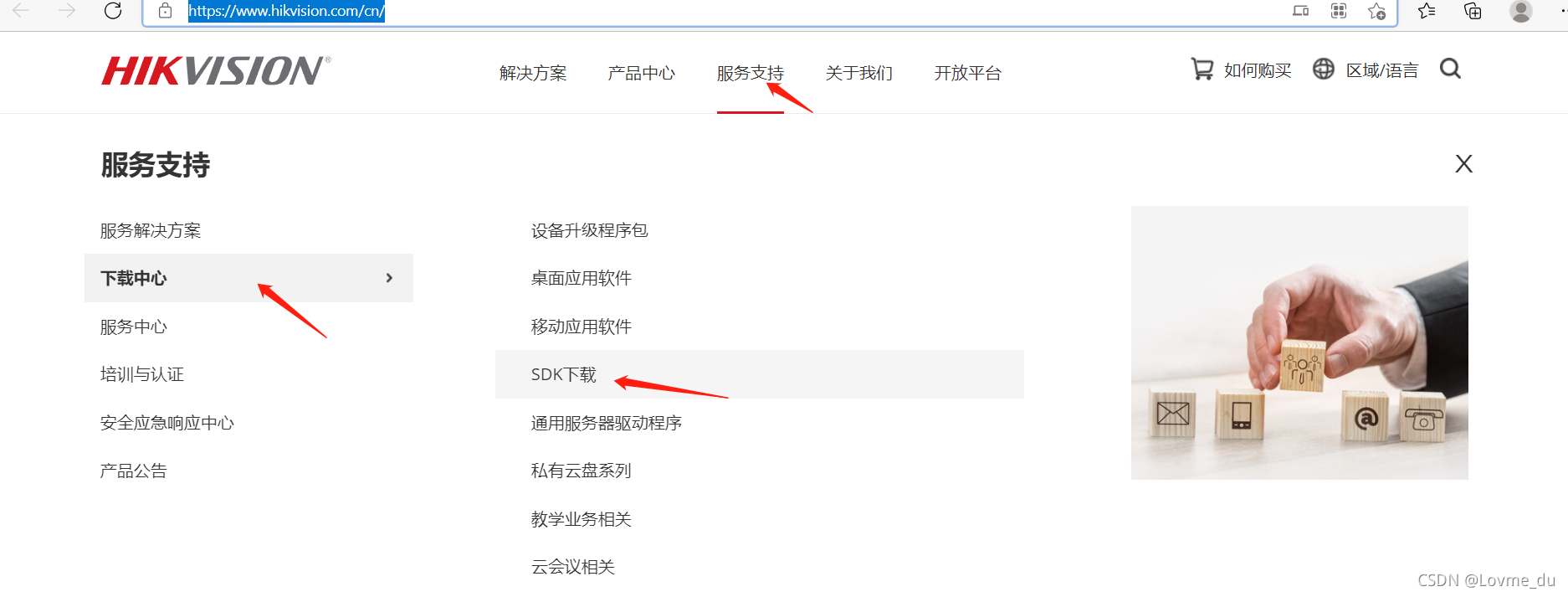功能背景:
项目里面使用到海康威视摄像头录播课堂,之后取出视频分享。
推荐内容
项目环境:
SpringBoot、JDK1.8、IntelliJ IDEA 2020.1、SDK V6.1、FFMPEG、康威视摄像头、录像机。
详细步骤:
一、引入SDK (海康威视 [官网入口] ),下载对应自己服务器版本的SDK,我选择的是《设备网络SDK_Win64 V6.1.6.45_build20210302》。
二、下载SDK解压后,如图:
- Demo示例 :里面有个java Demo可以提供参考。
- 开发文档:设备网络SDK使用手册.chm这个文档帮助大,其它我看不习惯。
- 库文件:dll文件引用。
- 头文件:非java使用观看的文件。
- HCNetSDKCom文件夹必须加载到工程.txt :说明文件。
三、库文件准备,打开SDK解压文件夹找到【库文件】里的HCNetSDK.dll、HCCore.dll、PlayCtrl.dll、SuperRender.dll、AudioRender.dll、HCNetSDKCom文件夹、ssleay32.dll、libeay32.dll、hlog.dll、hpr.dll、zlib1.dll、log4cxx.properties等文件均要加载到程序里面,【HCNetSDKCom文件夹】(包含里面的功能组件dll库文件)需要和HCNetSDK.dll、HCCore.dll一起加载,放在同一个目录下,且HCNetSDKCom文件夹名不能修改。拷贝到D盘自己创建的文件夹内。
四、新创建一个SpringBoot项目,pom文件引入SDK二次开发所需要的jar包,手动引入可以拷贝下载的SDK JAVA Demo里面有。
- 手动引入方式拷贝
CH-HCNetSDKV6.1.6.45_build20210302_win64\Demo示例\4- Java 开发示例\1-ClientDemo\ClientDemo-NetBeansPro下的 jna.jar、examples.jar - maven
<!--海康威视-->
<dependency>
<groupId>net.java.jna</groupId>
<artifactId>jna</artifactId>
<version>1.0.0</version>
</dependency>
<dependency>
<groupId>net.java.examples</groupId>
<artifactId>examples</artifactId>
<version>1.0.0</version>
</dependency>
五、找到下载JAVA Demo中的HCNetSDK.java文件,拷贝到自己新建的项目里面,修改dll引入路径。
HCNetSDK INSTANCE = (HCNetSDK) Native.loadLibrary("D:\\Hk\\HCNetSDK.dll",HCNetSDK.class);
六、创建类 DVRLogin.java
import lombok.Data;
/**
* 登录录像机对象
*/
@Data
public class DVRLogin {
/**
* 视频服务器ip地址
*/
private String ip;
/**
* 视频服务器端口号
*/
private int report;
/**
* 视频服务器用户名
*/
private String userName;
/**
* 视频服务器密码
*/
private String password;
public DVRLogin() {
}
public DVRLogin(String ip, int report, String userName, String password) {
this.ip = ip;
this.report = report;
this.userName = userName;
this.password = password;
}
}
七、创建测试类 VideoDowload.java
import com.sun.jna.NativeLong;
import com.sun.jna.ptr.IntByReference;
import java.io.File;
import java.text.ParseException;
import java.text.SimpleDateFormat;
import java.util.Date;
import static com.xzl.hk.FfmpegUtil.executeCodecs;
public class VideoDowload {
private static HCNetSDK hcNetSDK = HCNetSDK.INSTANCE;
private NativeLong userId;//用户句柄
private NativeLong loadHandle;//下载句柄
/**
* 按时间下载视频
*/
private boolean downloadVideo(DVRLogin DVRLogin, Date startTime, Date endTime, String filePath, int channel) {
boolean initFlag = hcNetSDK.NET_DVR_Init();
if (!initFlag) { //返回值为布尔值 fasle初始化失败
System.err.println("hksdk(视频)-海康sdk初始化失败!");
return false;
}
HCNetSDK.NET_DVR_DEVICEINFO_V30 deviceInfo = new HCNetSDK.NET_DVR_DEVICEINFO_V30();
userId = hcNetSDK.NET_DVR_Login_V30(DVRLogin.getIp(), (short) DVRLogin.getReport(), DVRLogin.getUserName(), DVRLogin.getPassword(), deviceInfo);
System.out.println("hksdk(视频)-登录海康录像机信息,状态值:" + hcNetSDK.NET_DVR_GetLastError());
long lUserId = userId.longValue();
if (lUserId == -1) {
System.err.println("hksdk(视频)-海康sdk登录失败!");
return false;
}
loadHandle = new NativeLong(-1);
if (loadHandle.intValue() == -1) {
loadHandle = hcNetSDK.NET_DVR_GetFileByTime(userId, new NativeLong(channel), getHkTime(startTime), getHkTime(endTime), filePath);
System.out.println("hksdk(视频)-获取播放句柄信息,状态值:" + hcNetSDK.NET_DVR_GetLastError());
if (loadHandle.intValue() >= 0) {
// 判断文件夹是否存在
File files = new File(filePath);
if (!files.exists()) {
files.mkdirs();
}
boolean downloadFlag = hcNetSDK.NET_DVR_PlayBackControl(loadHandle, hcNetSDK.NET_DVR_PLAYSTART, 0, null);
int tmp = -1;
IntByReference pos = new IntByReference();
while (true) {
boolean backFlag = hcNetSDK.NET_DVR_PlayBackControl(loadHandle, hcNetSDK.NET_DVR_PLAYGETPOS, 0, pos);
if (!backFlag) {//防止单个线程死循环
return downloadFlag;
}
int produce = pos.getValue();
if ((produce % 10) == 0 && tmp != produce) {//输出进度
tmp = produce;
System.out.println("hksdk(视频)-视频下载进度:" + "==" + produce + "%");
}
if (produce == 100) {//下载成功
hcNetSDK.NET_DVR_StopGetFile(loadHandle);
loadHandle.setValue(-1);
hcNetSDK.NET_DVR_Logout(userId);//退出录像机
System.out.println("hksdk(视频)-退出状态" + hcNetSDK.NET_DVR_GetLastError());
hcNetSDK.NET_DVR_Cleanup();
try {
// 视频进行转码
executeCodecs();
File file = new File(filePath);
// 如果文件路径所对应的文件存在,并且是一个文件,则直接删除
file.delete();
} catch (Exception e) {
e.printStackTrace();
}
return true;
}
if (produce > 100) {//下载失败
hcNetSDK.NET_DVR_StopGetFile(loadHandle);
loadHandle.setValue(-1);
System.err.println("hksdk(视频)-海康sdk由于网络原因或DVR忙,下载异常终止!错误原因:" + hcNetSDK.NET_DVR_GetLastError());
hcNetSDK.NET_DVR_Logout(userId);//退出录像机
logger.info("hksdk(视频)-退出状态"+hcNetSDK.NET_DVR_GetLastError());
return false;
}
}
} else {
System.out.println("hksdk(视频)-下载失败" + hcNetSDK.NET_DVR_GetLastError());
return false;
}
}
return false;
}
/**
* 获取海康录像机格式的时间
*/
private HCNetSDK.NET_DVR_TIME getHkTime(Date time) {
HCNetSDK.NET_DVR_TIME structTime = new HCNetSDK.NET_DVR_TIME();
String str = new SimpleDateFormat("yyyy-MM-dd-HH-mm-ss").format(time);
String[] times = str.split("-");
structTime.dwYear = Integer.parseInt(times[0]);
structTime.dwMonth = Integer.parseInt(times[1]);
structTime.dwDay = Integer.parseInt(times[2]);
structTime.dwHour = Integer.parseInt(times[3]);
structTime.dwMinute = Integer.parseInt(times[4]);
structTime.dwSecond = Integer.parseInt(times[5]);
return structTime;
}
public static void main(String[] args) {
SimpleDateFormat sdf = new SimpleDateFormat("yyyyMMddHHmmss");
Date startTime = null;
Date endTime = null;
try {
startTime = sdf.parse("20211101113000"); //开始时间
endTime = sdf.parse("20211101113035"); //结束时间
} catch (ParseException e) {
e.printStackTrace();
}
VideoDowload test = new VideoDowload();
DVRLogin DVRLogin = new DVRLogin("192.168.1.29", 8000, "admin", "abc123456");
int channel = 33;//通道
System.out.print(test.downloadVideo(DVRLogin, startTime, endTime, "D:\\testhk\\test_other.mp4", channel));
try {
executeCodecs();
} catch (Exception e) {
e.printStackTrace();
}
}
}
八、创建两个工具类FfmpegUtil.java、StreamGobbler.java。
FfmpegUtil.java,解决Jna抓取的视频文件不能播放问题,视频格式是MPEG-PS,需要转文件。
import java.io.IOException;
public class FfmpegUtil {
// ffmpeg.exe存放的位置
private static String ffmpegEXE = "D:\\tools\\ffmpeg\\bin\\ffmpeg.exe";
public static void executeCodecs() {
// 创建一个List集合来保存转换视频文件为flv格式的命令
// 拼接命令
String command = ffmpegEXE + " -i D:\\testhk\\test_other.mp4 -y -vol 1800 -ar 44100 -r 29.97 -s 1920x1080 D:\\testhk\\demp_other_encan1.mp4";
// 执行命令行
try {
Process process = Runtime.getRuntime().exec(command);
StreamGobbler errorGobbler = new StreamGobbler(process.getErrorStream(), "ERROR");
StreamGobbler outGobbler = new StreamGobbler(process.getInputStream(), "STDOUT");
// kick off stderr
errorGobbler.start();
outGobbler.start();
try {
int i = process.waitFor();
if (i == 0) {
System.out.println("进程完成.");
} else {
System.out.println("进程失败.");
}
} catch (InterruptedException e) {
System.out.println("进程失败!");
e.printStackTrace();
}
int i = process.exitValue(); //接收执行完毕的返回值
if (i == 0) {
System.out.println("执行完成.");
} else {
System.out.println("执行失败.");
}
} catch (IOException e) {
e.printStackTrace();
}
}
public static void main(String[] args) {
try {
executeCodecs();
} catch (Exception e) {
e.printStackTrace();
}
}
}
StreamGobbler.java 解决process.waitFor();阻塞进程。
import lombok.SneakyThrows;
import java.io.BufferedReader;
import java.io.IOException;
import java.io.InputStream;
import java.io.InputStreamReader;
import java.io.OutputStream;
import java.io.PrintWriter;
/**
* 用于处理Runtime.getRuntime().exec产生的错误流及输出流
*/
public class StreamGobbler extends Thread {
InputStream is;
String type;
OutputStream os;
StreamGobbler(InputStream is, String type) {
this(is, type, null);
}
StreamGobbler(InputStream is, String type, OutputStream redirect) {
this.is = is;
this.type = type;
this.os = redirect;
}
@SneakyThrows
public void run() {
InputStreamReader isr = null;
BufferedReader br = null;
PrintWriter pw = null;
try {
if (os != null)
pw = new PrintWriter(os);
isr = new InputStreamReader(is);
br = new BufferedReader(isr);
String line = null;
while ((line = br.readLine()) != null) {
if (pw != null)
pw.println(line);
System.out.println(type + ">" + line);
}
if (pw != null)
pw.flush();
} catch (IOException ioe) {
ioe.printStackTrace();
} finally {
if (pw != null) {
pw.close();
}
if (br != null) {
br.close();
}
if (isr != null) {
isr.close();
}
}
}
}
注意:上面内容中使用到 ffmpeg 安装教程。

